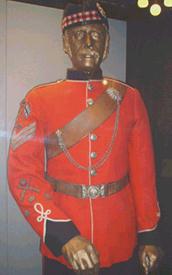
3rd LRV Uniform
Ingrams Photo Gallery3rd Lanarkshire Volunteer Rifles |

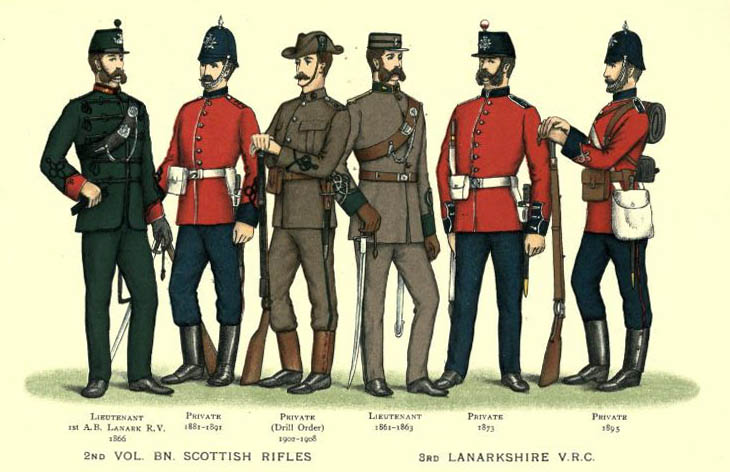
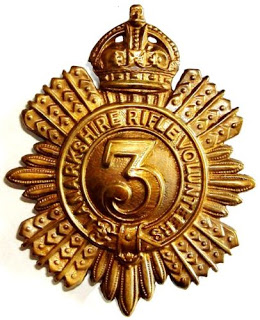
Formation:
Volunteer forces were first raised during the Napoleonic Wars but most were then subsequently disbanded after the French defeat at Waterloo in 1815.
However French naval expansion in the 1850's caused 'invasion panic' and in 1859 Volunteer Corps were re-created. Members of the corps received no pay and provided their own uniforms and equipment.
The Lanarkshire Volunteers comprised the 1st, 2nd, 3rd and 4th Corps. The 3rd Lanarkshire Volunteers were based in the Strathbungo area on the south side of Glasgow.
The 3rd Lanarkshire Corp was formed by the combination of several independent units including the '8th Coy Etna Foundry' and the remainder of the '78th Corps Old Guard of Glasgow.'
The increasing 'professionalism' of the volunteer corps was recognised in the Volunteers Act of 1863 by which time the Volunteers could be called out for active military service instead of being deployed solely for defence purposes.
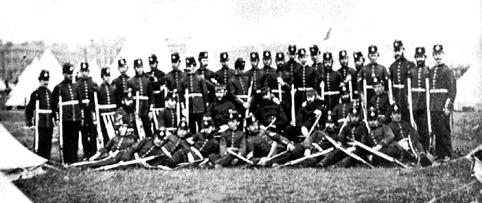
3rd Lanarkshire Volunteers Camp of Instruction - Strathbungo, 1873
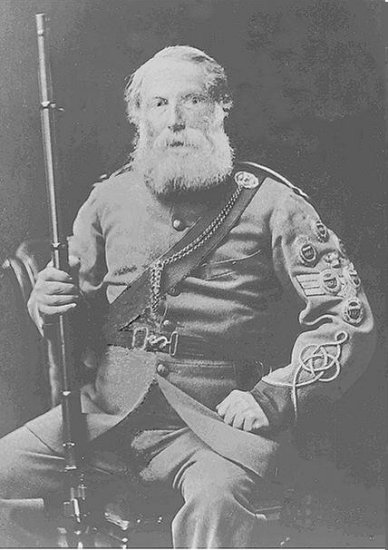
( 1816 - 1885 ) Sergeant in the 1st Lanarkshire Volunteer Rifles "Old
Charley" was a highly respected marksman
and a frequent prizewinner. |
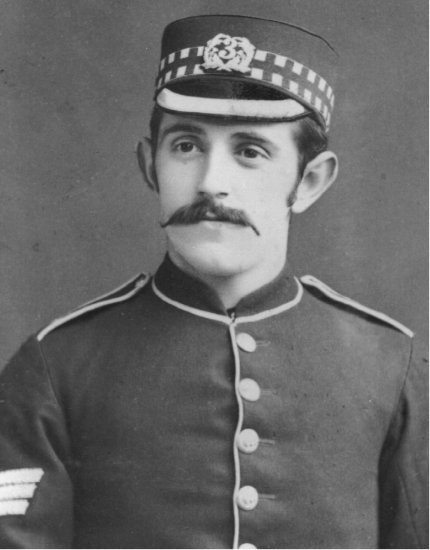 (
1863 - 1928 ) Sergeant
in 3rd Lanarkshire Volunteer Rifles
|
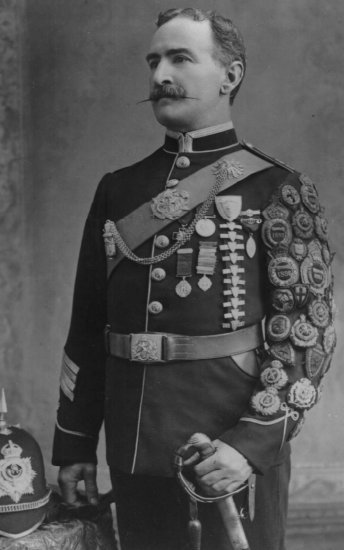 ( 1856 - 1931 ) Colour
Sergeant
3rd Lanarkshire Volunteer Rifles |
Third Lanark FC:
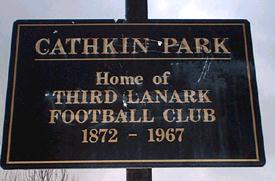
The
first Scotland v England football
international match at Hamilton Crescent,
Glasgow
in 1872 inspired the regiment to start a football team of their
own and this
was one of the
original members of the Scottish
Football
Association.
1) a scarlet Guernsey or Jersey ( the colour of the regiment uniform )2) blue trousers or knickerbockers
3) blue stockings.
At a subsequent meeting it was decreed
that the number 3 should be displayed on the Guernsey.
The first playing field of the team was the Regimental drill ground at Victoria Road, Glasgow to the south of the Regimental Headquarters before a move to a 'new' ground at Old Cathkin Park in 1875.
A grandstand was built in 1878 and in 1884 Old Cathkin Park was chosen as the venue for the annual Scotland v England match - a 1-0 win for Scotland - their 5th win in a row against the 'Auld Enemy'!
Army Developments:
In May 1881 there was a major reorganisation in the British army and regiments ceased to be numbered and instead took names associated with their recruiting area or an element of their history.
The Volunteer Corps were now linked with the regular army and the four Lanarkshire Rifle Volunteer Corps became the 1st, 2nd, 3rd and 4th Volunteer Battalions attached to the Cameronians ( Scottish Rifles ).
The Cameronians ( Scottish Rifles ) were formed in 1881 by amalgamating two single-battalion regiments: The Cameronians or the 26th Regiment Foot ( raised in 1689 ), and the 90th Perthshire Light Infantry ( raised in 1794 ), which respectively became the 1st and 2nd Battalions of the new Regiment.
The Cameronians were unique in that they were the only regiment in the British Army to have a religious origin - having been formed by Covenanters.
Each regiment now had two regular service battalions, one based at home recruiting and training, and one serving overseas. At regular intervals the two battalions would exchange roles.
The 1st Battalion took the name The Cameronians, whilst the other Battalions, including the Volunteers, were known as Scottish Rifles. This distinction remained until the 1920s when all Battalions assumed the Regiment's full name.
It was the wish of Queen Victoria that the Regiment became a rifle regiment, due to their skill as marksmen, rather than ordinary infantry thus becoming the only Scottish Rifle Regiment. By army tradition this distinction was considered a great honour.
Meanwhile the increase in professionalism in the football club meant that changes here were also pending and the tenuous link with the regiment was finally severed in 1903 when they became a limited company and dropped the regimental title from their name ( although retaining the colours of the Rifle Volunteers ) and re-registered with the Scottish League as the 'Third Lanark Athletic Club'.
The Haldane Army reforms of 1908 ended the renowned name of the 3rd Lanarkshire Rifle Volunteers when they were disbanded and reformed as the 7th Territorial Battalion of the Cameronians ( Scottish Rifles ). The 1st, 2nd and 4th Volunteers became the 5th, 6th and 8th Territorial Battalions.
The turning point for the Volunteers came when they served overseas for the first time in the Boer War and distinguished themselves fighting alongside regular battalions.
The ultimate test for the new territorial battalions came with the advent of The Great War on 4th August 1914 - the time had come for the old 3rd Lanarkshire Rifle Volunteers in the guise of the 7th Battalion Cameronians ( Scottish Rifles ) to make their mark in the Great War.
They were part of 156th Brigade of the
52nd ( Lowland ) Division and were
detailed along with their sister battalion the 8th Scottish Rifles and
the
7th Royal Scots to head for Gallipoli.
Due to the resulting losses the two Rifle battalions were combined into the 7th/8th Scottish Rifles.
The decision was finally taken to evacuate the peninsula and the removal of troops began in December and concluded by early January 1916.
The remaining members of the 7th/8th Scottish Rifles were one of the last units to leave. The 7th and 8th battalions had arrived on the 14th June 1915 with 2200 officers and men and left on the 9th January 1916 with a combined strength of 130.
It has to be assumed that the last members of the old 3rd Lanarkshire Rifle Volunteers were lost on the Gallipoli peninsula.
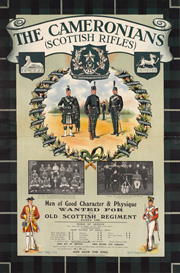
After The Great War ended in 1919 the 1st and 2nd Cameronians ( Scottish Rifles ) returned to peacetime duties while the territorials returned to their previous calling or were disbanded.
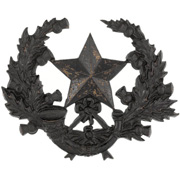
Cameronians Cap Badge
World War II brought the Cameronians out of 'retirement' and the 7th Battalion was again to distinguish itself after the D-Day landings in 1944.
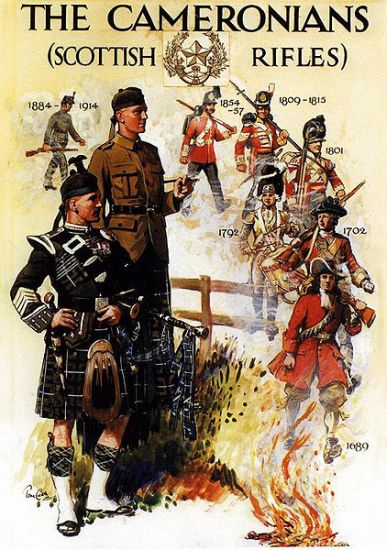
Twelve months later the football team founded by the forebears of the 7th Cameronians was in deep financial trouble. Third Lanark were now playing in the Scottish League Division 2 and played their last match against Dumbarton FC on 28th April 1967.
A Court Order in June of 1967 finally closed the turnstyles at Cathkin Park.
The famous names of Third Lanark FC and 3rd Lanarkshire Rifle Volunteers are now consigned to history.
Site Index | Worldwide Mountaineering | Adventure Travel